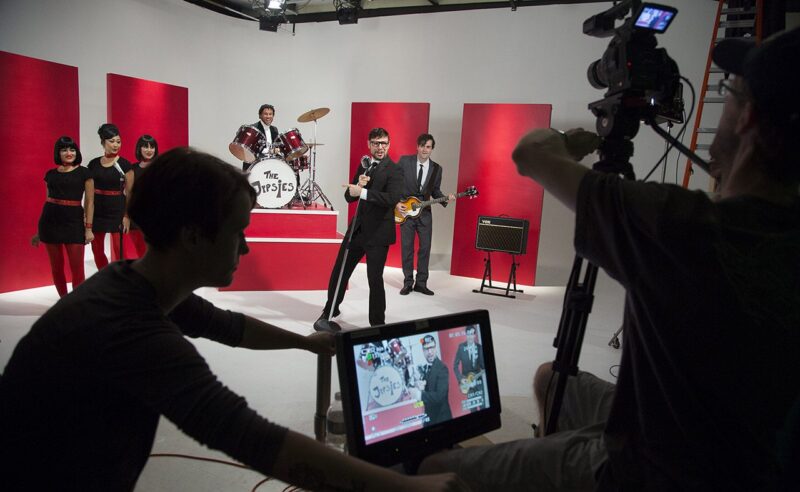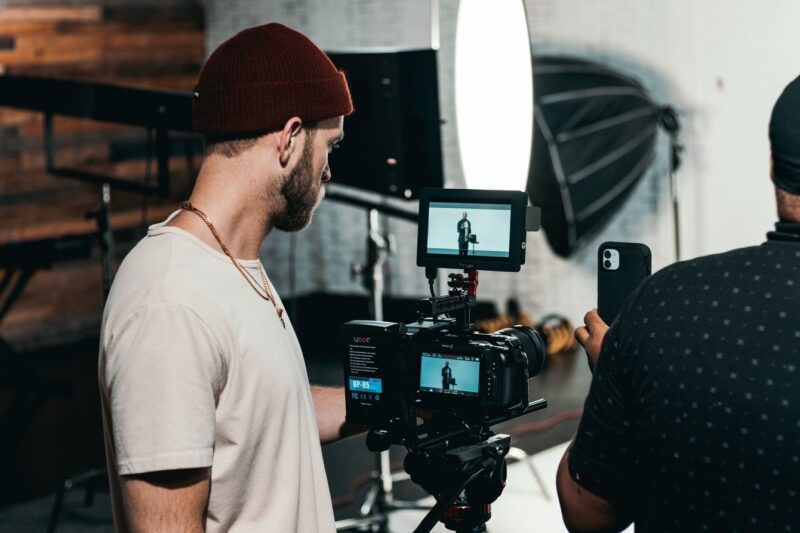Embarking on the journey of music video production is both exhilarating and challenging. With the rise of platforms like YouTube and TikTok, the demand for captivating visual content has surged, making it vital for artists to stand out in a crowded space.
Whether you’re an independent musician looking to create a stunning visual narrative or a seasoned professional aiming to elevate your work, understanding the intricate steps involved in bringing your vision from concept to screen is paramount.
Key Takeaways
- Prioritize pre-production planning to outline your vision and objectives.
- Define your target audience for enhanced engagement.
- Craft a compelling storyboard to visualize the narrative flow.
- Assemble a skilled production team to bring expertise to your project.
- Utilize effective shooting techniques to enhance the overall quality of your video.
- Incorporate thoughtful editing and sound design in post-production.
- Seek constructive feedback to refine the final product.
Understanding the Foundations of Music Video Production

Gaining a firm grasp of the foundations of music video production is essential for achieving your artistic vision. Effective pre-production planning plays a pivotal role in this process. Without thorough preparation, you risk delays and misunderstandings that can derail your project.
Importance of Pre-Production Planning
Pre-production planning involves various critical tasks such as scouting locations, casting appropriate talent, and establishing a detailed production schedule. This phase acts as a roadmap, ensuring that every team member understands their tasks and responsibilities. A comprehensive plan alleviates risks associated with unforeseen challenges and keeps the production organized.
Defining Your Objectives and Audience
Defining objectives is key to guiding the creative direction of your music video. Consider whether your goal is to enhance artist branding, boost audience engagement, or convey a specific message. Identifying your target audience informs your content choices and influences the music video concepts you develop. Knowing who will view your video allows for tailored messaging that resonates with viewers.
Establishing a Realistic Budget
Establishing a budget is crucial for any successful project. Costs can accumulate quickly in music video production, making financial planning essential. A realistic budget helps allocate resources effectively while balancing quality and expenses. Keep in mind potential expenses such as location fees, equipment rental, and talent compensation to avoid financial pitfalls.
| Pre-Production Task | Purpose | Key Considerations |
| Location Scouting | Find ideal settings for the music video | Accessibility, aesthetics, logistic costs |
| Casting Talent | Select performers that fit the music video vision | Experience, compatibility with brand image |
| Production Schedule | Outline the timeline for filming and editing | Deadlines, availability of team and locations |
| Budget Estimation | Predict overall costs and allocate funds | Realistic pricing, contingencies for unexpected expenses |
From Concept to Screen ─ Effective Tips for Music Video Production

Transitioning your music video idea from concept to screen involves several crucial steps. Each phase plays a vital role in achieving a final product that resonates with viewers. Focus on these key areas for successful execution.
Creating a Compelling Storyboard
Creating a storyboard serves as the foundation for your music video. This visual representation outlines each scene, making it easier to visualize the narrative flow. It helps identify camera angles, shot composition, and transitions, ensuring you stay structured during video production.
Choosing the Right Team
Choosing a team is essential for elevating your video project. Assembling a diverse crew, including a skilled director, cinematographer, and sound engineer, contributes to a polished final product. Effective collaboration among team members can significantly impact the video’s quality and overall vision.
Casting and Location Scouting
Casting talent who fit your vision is crucial. The right performers not only bring energy but also depth to your storyline. Equally important is location scouting; select locations that enhance the mood of the video and tell a more compelling story visually.
Implementing Effective Video Shooting Techniques
Implementing effective video shooting techniques can greatly influence the outcome of your project. Techniques such as dynamic camera movements, proper lighting, and creative angles enhance visual storytelling. Ensuring every shot is carefully planned fosters a strong narrative connection with your audience.
| Aspect | Importance | Tips |
| Storyboard | Visual roadmap for the video | Sketch scenes, define transitions |
| Team | High-quality production | Choose experts, promote collaboration |
| Casting | Brings the vision to life | Look for authenticity, chemistry |
| Locations | Enhances storytelling | Scout diverse settings, consider accessibility |
| Shooting Techniques | Improves visual appeal | Vary angles, adjust lighting dynamically |
Post-Production Essentials for a Successful Music Video

Post-production is where your music video transforms into a polished final piece. Effective editing techniques are crucial for enhancing visual storytelling, allowing your narrative to resonate with viewers.
Focus on creating a seamless flow in your footage through careful post-production editing. Techniques such as jump cuts, cross-fades, and slow-motion can impart the desired rhythm and pace, aligning with the song’s energy.
Editing Techniques That Enhance Visual Storytelling
Utilizing various editing styles can greatly amplify the emotional depth of your music video. Techniques to consider include:
- Continuity editing to maintain narrative coherence
- Montage sequences for dynamic pacing
- Color grading to set the mood
- Transitions that evoke feelings aligned with the music
By thoughtfully applying these techniques, you’ll elevate your visual storytelling to new heights, creating a captivating experience for your audience.
Incorporating Sound Design and Music

Integrating sound design and incorporating music are essential elements in post-production. The audio needs to complement the visuals effectively, creating an engaging atmosphere. Focus on balancing dialogue, sound effects, and the musical score. Well-designed sound enhances the emotional impact, pulling viewers deeper into the story.
Consider using foley effects to enrich sound environments or layering ambient sounds that correspond with the visuals. This creates a more immersive experience that resonates on multiple levels with your audience.
Reviewing and Seeking Feedback for Refinement
After completing your editing, it’s vital to conduct an audience review. Gather a focus group to receive valuable feedback on your music video. Encourage honest critiques regarding pacing, visual appeal, and the efficacy of sound design and music incorporation. You can also consider consulting experts like those at robertdevico.com.
Conclusion
Music video production is a multi-faceted journey that requires careful consideration and strategic planning from concept to screen. By implementing the music video production tips highlighted throughout this guide, you can enhance the quality of your videos significantly, ensuring they resonate with the audience.
The focus on thorough pre-production planning, efficient shooting techniques, and thoughtful post-production practices will elevate your narrative and reinforce brand engagement.

